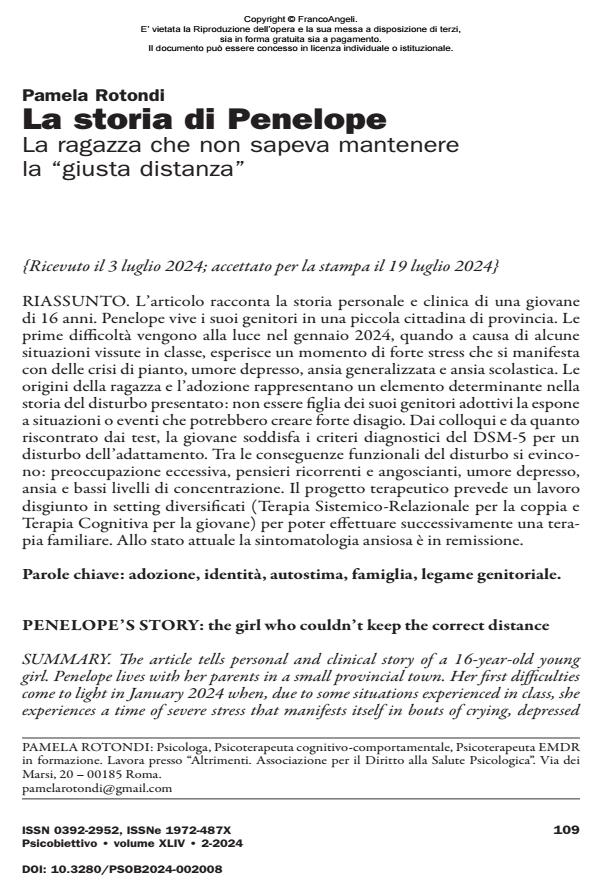Penelope’s story: the girl who couldn’t keep the correct distance
Journal title PSICOBIETTIVO
Author/s Pamela Rotondi
Publishing Year 2024 Issue 2024/2
Language Italian Pages 7 P. 109-115 File size 604 KB
DOI 10.3280/PSOB2024-002008
DOI is like a bar code for intellectual property: to have more infomation
click here
Below, you can see the article first page
If you want to buy this article in PDF format, you can do it, following the instructions to buy download credits

FrancoAngeli is member of Publishers International Linking Association, Inc (PILA), a not-for-profit association which run the CrossRef service enabling links to and from online scholarly content.
The article tells personal and clinical story of a 16-year-old young girl. Penelope lives with her parents in a small provincial town. Her first difficulties come to light in January 2024 when, due to some situations experienced in class, she experiences a time of severe stress that manifests itself in bouts of crying, depressed mood, generalized anxiety and school anxiety. The girl’s origins and adoption represent a determining element in the history of the disorder presented: not being a child of her adoptive parents exposes her to situations, or events, that could create severe distress. From the interviews and test results, the young girl meets the DSM-5 diagnostic criteria for an adjustment disorder. Functional consequences of the disorder include: excessive worrying, recurrent distressing thoughts, mood depressed, anxiety, and low levels of concentration. The therapeutic design involves disjointed work in diverse settings (Therapy Systemic-Relational Therapy for the couple and Cognitive Therapy for the young person) in order to be able to carry out family therapy later. At present, the anxiety symptomatology is in remission.
Keywords: adoption, identity, self-esteem, family, parental bond.
- Dimaggio G., Semerari A. (a cura di) (2003). I disturbi di personalità. Modelli e trattamento. Stati mentali, metarappresentazione, cicli interpersonali. Roma-Bari: Laterza.
- Fonagy P., Steele M., Steele H., Moran G.S., Higgit A.C. (1991). The capacity of understanding mental states: the reflective self/parent in mother and child and its significance for security of attachment. Infant Mental Health Journal, 12(3): 201-218.
- Juffer F., Bakermans-Kranenburg M.J., Van IJzendoorn M.H. (2005). The importance of parenting in the development of disorganized attachment: Evidence from a preventive intervention study in adoptive families. Journal of Child psychology and Psychiatry, 46: 263-274.
- Liotti G., Farina B. (2011). Sviluppi Traumatici. Eziopatogenesi, clinica e terapia della dimensione dissociativa. Milano: Raffaello Cortina Editore.
- Liotti G., Monticelli F. (2014). Teoria e clinica dell’alleanza terapeutica: la prospettiva cognitivo-evoluzionista. Milano: Raffaello Cortina Editore.
- Ongari B. (2009). La trasmissione intergenerazionale dell’attaccamento nell’adozione: una questione aperta. International Journal of Developmental and Educational Psychology, 3(1): 349-355.
Pamela Rotondi, La storia di Penelope. La ragazza che non sapeva mantenere la “giusta distanza” in "PSICOBIETTIVO" 2/2024, pp 109-115, DOI: 10.3280/PSOB2024-002008